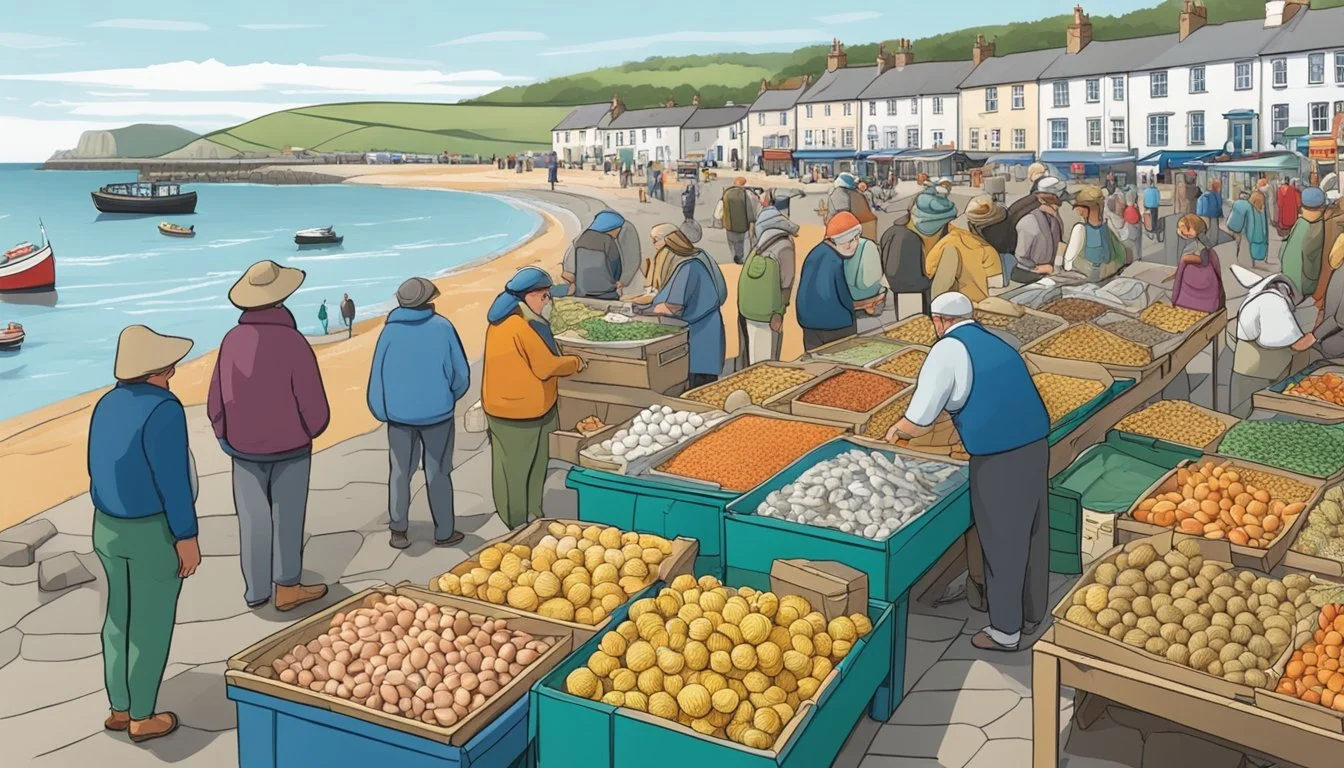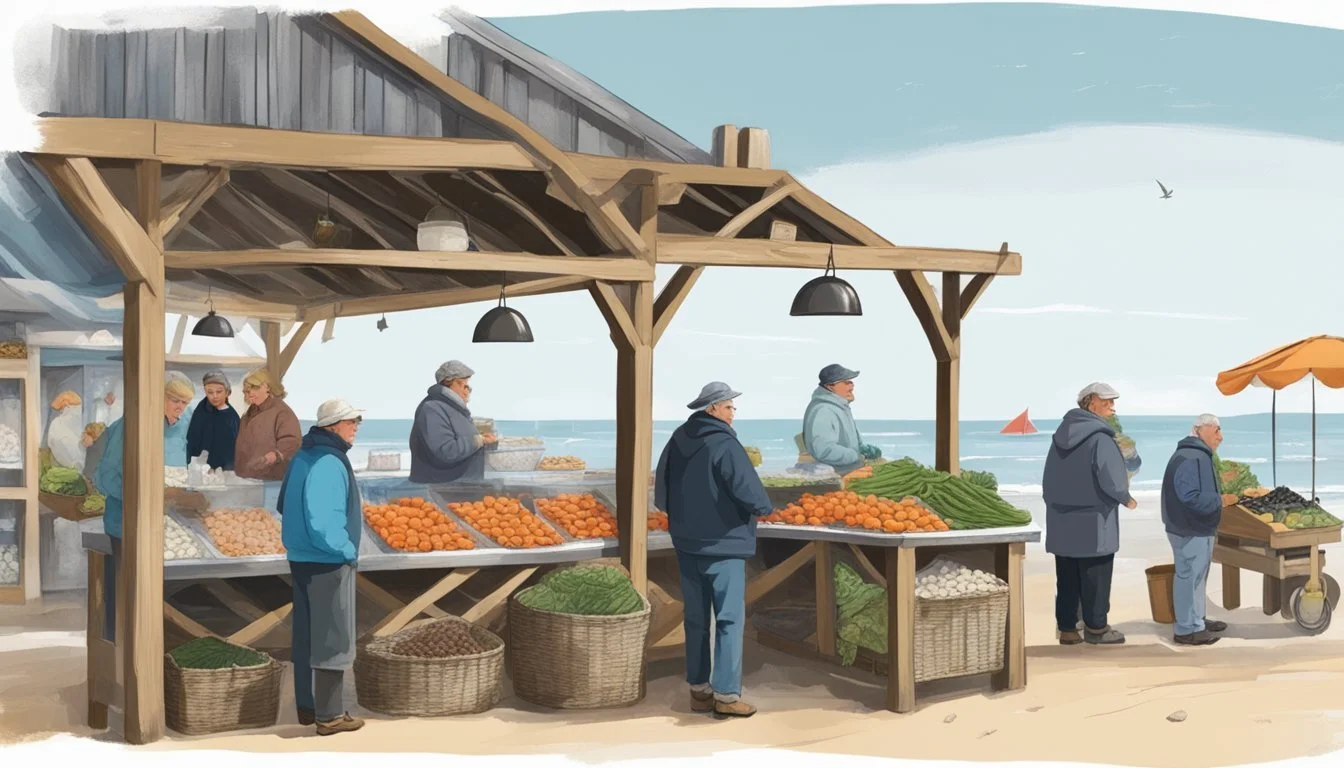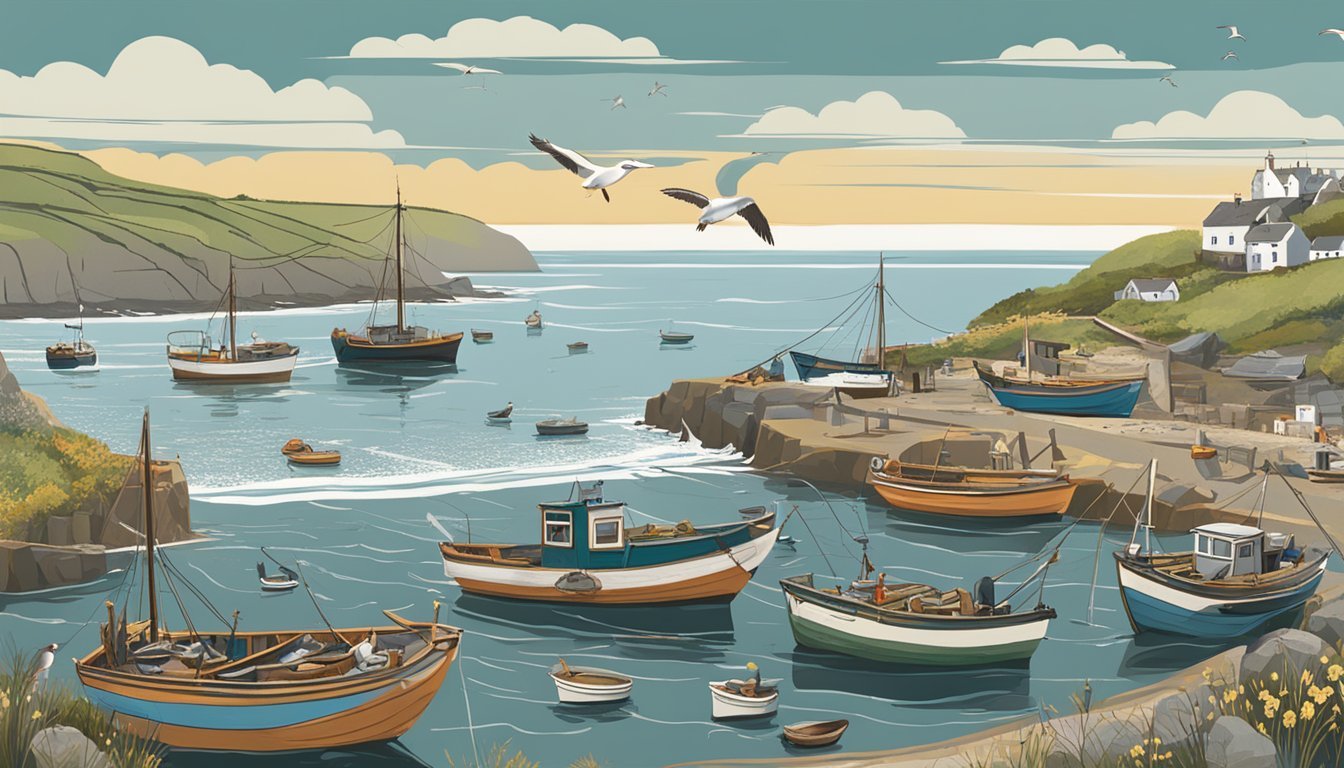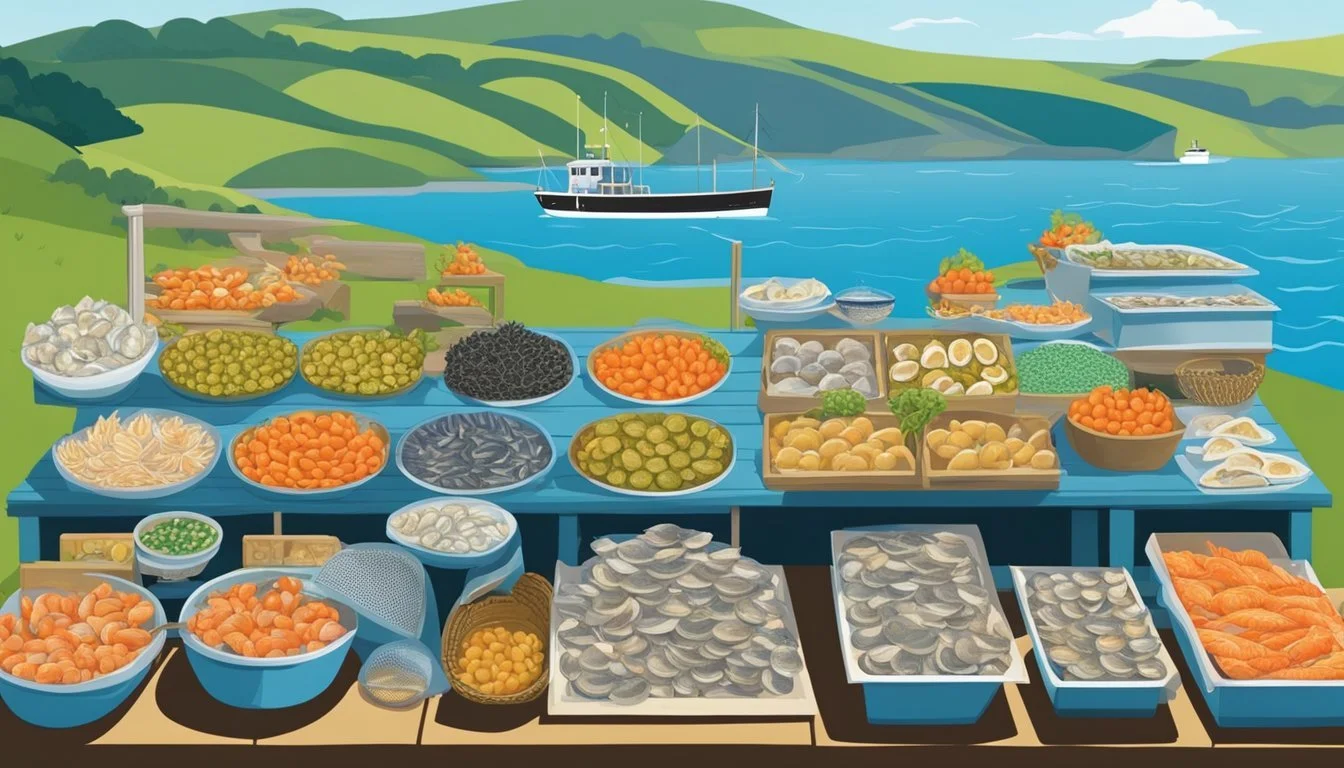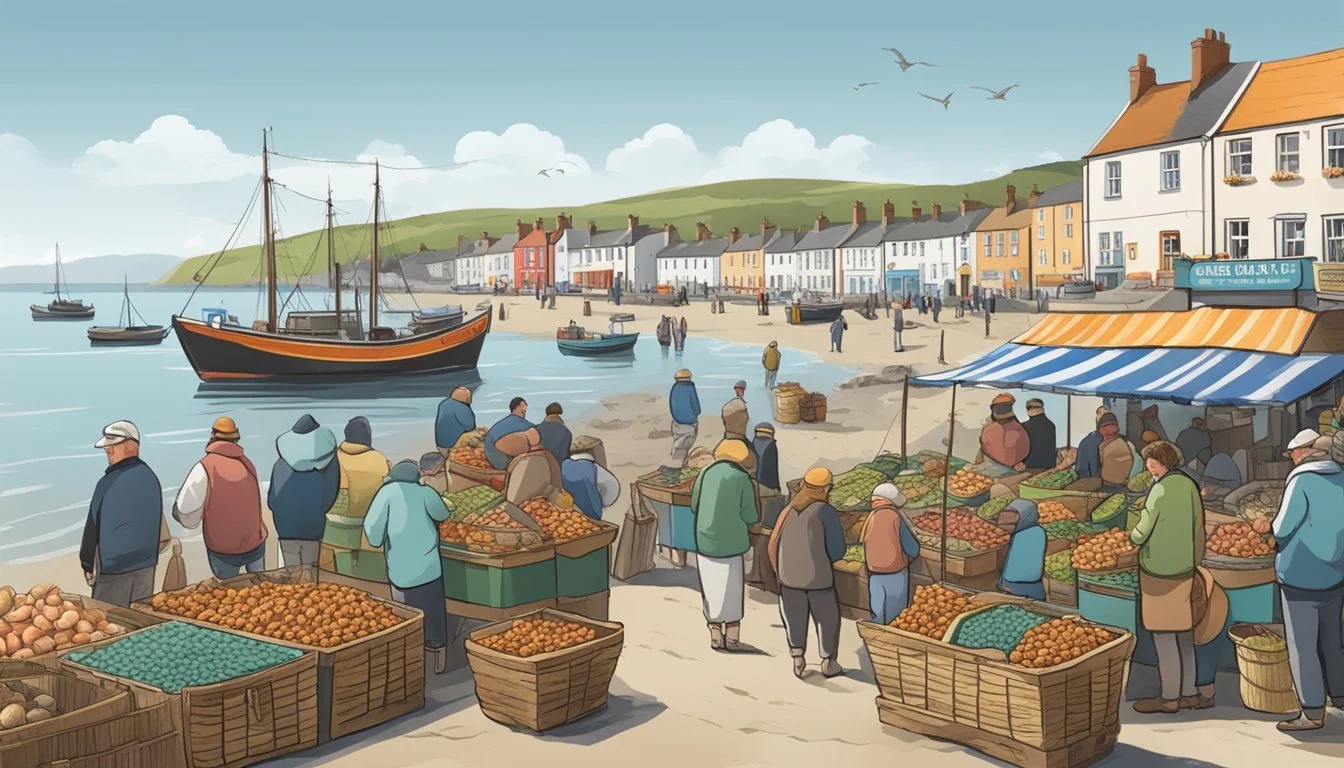Cockles
The Traditional Welsh Seafood You Need to Try and Where to Find It
Cockles, small saltwater bivalves, are a culinary staple along the coast of Wales, particularly Swansea and surrounding areas with a history tracing back to Roman times. These hardy shellfish (What wine goes well with shellfish?) thrive in the sandy, tidal flats where they are sustainably harvested, making them a fixture in the local seafood (What wine goes well with seafood?) scene. While modest in size, their flavor is not to be underestimated. Rich in local culture, they offer a genuine taste of Welsh tradition and are often enjoyed steamed, or served cold with a simple yet classic dressing of malt vinegar and salt.
Welsh chefs and food enthusiasts have long celebrated cockles as a versatile ingredient, incorporating them into various dishes that command attention beyond their humble origins. From the bustling stalls of Swansea Indoor Market to serene coastal eateries, cockles are proudly presented in a myriad of preparations. A favored dish among locals includes the iconic combination of bacon, cockles, and laverbread—a type of seaweed also native to the region—served on sourdough toast, sometimes topped with a poached egg to create a beloved brunch (What wine goes well with brunch?) offering.
Not only do cockles infuse a distinct taste to Welsh cuisine, but they also contribute nutritive benefits. A source of lean protein, vitamins, and minerals, cockles are recognized for their low-fat content, aligning well with health-conscious dietary patterns. Their culinary usage reflects a balance of tradition and nutrition, symbolizing the camaraderie found in communities along the Welsh coastline where gathering and savoring seafood is a way of life.
Historical Significance of Cockles in Welsh Cuisine
Cockles have been an integral part of Welsh cuisine since Roman times, marking their presence along the Welsh coast. These small bivalve molluscs are more than just seafood; they embody the culinary history of Wales, signifying a connection to the nation's landscapes and past livelihoods.
Historically, the cockle industry thrived in coastal regions such as Penclawdd, a village renowned for its cockle gathering. Welsh coastal communities, relying on the abundance of these molluscs, developed various traditional methods of preparation, ensuring cockles remained a staple in the local diet.
Occupying a spot on the breakfast table, cockles often joined fried eggs and fatty bacon, contributing to a hearty start to the day. Their plump and sweet nature also meant they were served:
Steamed with malt vinegar and salt
Cold in various salads
Incorporated into dishes with pasta and rice
Cockles are not only savoured for their taste but also revered for their sustainable food source quality, supporting local families and economies through the decades. Markets in Swansea and Cardiff bear witness to this historic tradition, continuing to be reputable sources to procure fresh cockles.
As symbols of Welsh culinary heritage, the cockle's journey from coastal beds to the markets and tables remains firmly embedded in the collective memory of Wales. They stand as a testament to the nation’s ability to sustainably harness the riches of its coastal waters, translating into dishes that honor cultural and historical legacy.
Cockles: A Culinary Staple in Wales
Wales is renowned for its tradition of harvesting and savoring cockles, an esteemed seafood delicacy that provides a taste of the nation's culinary heritage.
Cockles and Their Nutritional Benefits
Cockles, small bivalve molluscs found in coastal regions, are a staple in South Wales. They are not only cherished for their flavor but also for their nutritional value. Rich in iron and low in calories, cockles provide essential minerals and proteins with each serving. Here's a brief overview of their nutritional benefits:
High in Protein: Essential for muscle repair and growth.
Low in Fat: Cockles are a lean source of protein.
Rich in Vitamins and Minerals: Especially vitamins B12 and iron, supporting healthy blood cells and energy levels.
Sourcing Cockles: From Sand to Table
Harvesting cockles in South Wales is a practice that dates back to Roman times. The cockles are typically gathered from the sandy beds of the Burry Estuary, especially in Penclawdd, which is famed for its cockle industry. During low tide, fishmongers collect cockles, ensuring that sustainable practices are followed to preserve this culinary tradition for future generations.
How They Are Collected:
Wait for low tide to expose sand beds.
Utilize a curved metal 'scrape' to unearth cockles.
Employ sustainable methods to protect cockle populations.
Preparing and Cooking Cockles
Once cockles are sourced and cleaned, they are ready to be cooked—a process that can be simple yet delightful. Recipes throughout South Wales often involve steaming them or serving them cold with vinegar and salt for a traditional taste. Here is a basic method of cooking:
Cooking Steps:
Rinse the cockles thoroughly in cold water to remove sand.
Steam until the shells open, then remove from heat.
Discard any unopened cockles as these are not safe to consume.
Cockles can also be added to a variety of dishes, from hearty stews to appetizers. They are a versatile ingredient that complements the flavors of garlic, shallots, and soy sauce, often featuring in recipes that require just a short cooking time to preserve their delicate taste and texture.
Complementary Pairings with Cockles
Cockles are a versatile seafood ingredient common in Welsh cuisine. They can be paired with a variety of ingredients to create dishes that are both flavorful and traditional.
Bacon, Cockles, and Laverbread: A Traditional Trio
The combination of bacon, cockles, and laverbread is essential to a traditional Welsh breakfast. They not only incorporate the salty richness of bacon but also the unique marine flavor of cockles, and the smooth, savory taste of laverbread—a type of seaweed. Together, these ingredients create a harmony of flavors that is often enjoyed by locals and recommended for visitors. This trio is typically seasoned with black pepper and a squeeze of lemon juice to enhance the taste.
From Toast to Pasta: Versatile Cockles Recipes
Cockles on Toast: A simple yet delicious way to enjoy cockles is on toast. This dish starts with a slice of crispy, golden-brown sour dough toast, topped with tender cooked cockles, and can be further enhanced with toppings like a poached egg for a perfect brunch option.
Cockles in Pasta: For those who prefer a heartier meal, cockles can be elegantly combined with pasta. Adding cockles to pasta, along with ingredients like garlic, olive oil, and fresh herbs, can transform a simple dish into a coastal culinary delight. Cook the pasta to al dente texture, mix in the sautéed cockles, and finish with a sprinkle of Parmesan for a satisfying meal.
Laverbread: The Welsh Seaweed Delicacy
Laverbread, derived from seaweed, is not bread but a traditional Welsh ingredient known for its deep cultural impact and nutritional benefits.
Laverbread: Origin and Cultural Importance
Laverbread, or bara lawr in Welsh, originates from the coastal regions of Wales where laver, a type of seaweed, thrives along the rocky shorelines. It has been a staple in Welsh cuisine for centuries, with a history rooted deeply in coastal communities. In local culture, laverbread holds significance akin to that of Welsh rarebit, another iconic dish from Wales. Nutritionally, laver is rich in minerals, vitamins, and iodine, making laverbread a healthful addition to the Welsh diet.
Cooking with Laverbread: Traditional and Modern Approaches
Traditionally, laver is boiled for several hours until it turns into a dark green or black paste, which can then be mixed with oatmeal and fried to create lavercakes. These are often served as part of a full Welsh breakfast, alongside bacon and cockles. Modern culinary applications have expanded the use of laverbread, incorporating it into dishes beyond breakfast. Chefs appreciate laverbread for its versatility and briny, umami flavour, incorporating it into sauces, pâtés, and as a complement to seafood or cheese in various recipes. Regardless of its application, laverbread remains a celebrated Welsh ingredient embracing both tradition and innovation in cooking.
The Ecosystem of Welsh Seafood
Welsh seafood, particularly bivalves like cockles, is part of a robust ecosystem that contributes significantly to Wales' culinary heritage and environmental health. The management of this resource prioritizes sustainability and ecological balance.
Sustainability and Environmental Impact
Cockles are among the shellfish that play a critical role in the Welsh seafood ecosystem due to their environmental benefits and contribution to sustainable food sources. The cockles found along the Welsh coast, particularly in regions like Penclawdd, thrive in tidal mudflats where they filter feed, which naturally cleans the water by removing toxins and increasing water clarity. This filtration process not only enhances the marine environment but also supports the growth of other marine species.
The Welsh cockle industry is committed to sustainable practices to ensure the future viability of this valuable resource. Cockle gatherers adhere to regulations that protect the environment, including restrictions on the size of the cockles collected and the times of the year when gathering is permitted. These measures prevent overharvesting and allow for the replenishment of stocks, thus preserving the natural cycle and the biodiversity of the region.
The sustainability of cockle fisheries is further ensured by monitoring the environmental impact of the industry. This includes adaptive management measures that respond to ecological changes, safeguarding the habitat. The Welsh Government has also modified permit systems to guarantee legitimate and safe gathering practices, thereby promoting responsible stewardship of the coastline's natural assets.
By maintaining a balance between harvesting practices and ecological protection, the Welsh seafood industry not only supports the local economy but also serves as a model for sustainable seafood production around the world.
Expanding Tastes: Welsh Seafood Beyond Cockles
Welsh cuisine offers a rich variety of seafood that extends well beyond the celebrated cockles. This section delves into the diverse offerings from the Welsh coast, illuminating alternatives that promise culinary delight.
A Taste of the Sea: Other Popular Welsh Shellfish
When venturing beyond cockles, one will find a treasure trove of shellfish in Wales. Mussels (What wine goes well with mussels?) and clams (What wine goes well with clams?) feature prominently within local dishes, providing a succulent taste of the sea’s bounty. Traditionally served steamed, these molluscs also pair well with various aromatic herbs, drawing out their delicate flavors.
Notable Welsh Shellfish:
Mussels: Often found in dishes like moules marinière with a Welsh twist.
Clams: A key ingredient in seafood stews and broths.
Introducing Welsh Seafood to a Global Palate
The appeal of Welsh seafood has transcended local markets, with excellent reception in cosmopolitan areas like London and international markets such as Japan and Spain. Welsh mussels have impressed with their quality and taste, regularly making their way into the sophisticated tapas scenes of Spanish cities. Meanwhile, in Japan, the appreciation for fine seafood has introduced a context where Welsh shellfish can be savored in a variety of traditional and fusion cuisines.
Global Markets for Welsh Seafood:
London: A hub for innovative Welsh seafood dishes (What wine goes well with seafood dishes?) in gourmet restaurants.
Japan: A new frontier where Welsh shellfish is used within refined culinary traditions.
Spain: A nation where the affinity for shellfish has led to the inclusion of Welsh mussels in tapas menus.
Incorporating Cockles into Modern Cuisine
Cockles have transitioned from a traditional snack to a highlight in contemporary kitchens. Chefs are embracing their rich flavor and nutrition, crafting dishes that meld time-honored tastes with international culinary trends.
Fusion Dishes: Blending Cockles with International Flavors
Modern cuisine often celebrates the combination of local ingredients with global influences. In Wales, cockles are being elevated through fusion dishes that introduce them to the exotic flavors of international kitchens. For instance, a recipe may pair the natural saltiness of cockles with the zest of lemon juice, creating a dish that balances the hearty taste of the sea with citrus freshness.
Cockles with Asian Fusion: They can be stir-fried with ginger, garlic, and a splash of soy sauce for an Asian twist.
Mediterranean Influences: They may also star in paellas or pasta, where they are simmered in white wine with a mix of herbs, embracing a more Mediterranean flair.
Innovative Recipes: Cockles Meets Global Ingredients
Chefs are also introducing cockles in recipes that push the boundaries of traditional seafood dishes. They're experimenting with global ingredients, adding complexity and variety to the simple cockle.
Cockles in Modern Appetizers: A recipe for cockles could include marinating them in malt vinegar and serving on a small plate with artisanal breads.
Cockles as a Gourmet Main: Incorporating cockles into a main course might involve baking them with a sauce of white wine, cream, and a hint of lemon juice, emphasizing their fresh, delicate taste.
The adaptability of cockles to different cooking methods and their compatibility with a wide range of ingredients make them an ideal choice for creative modern cuisine recipes.
Enjoying Cockles in Social Settings
Cockles, a beloved Welsh seafood, are not just a culinary treat but also a social catalyst, often enjoyed among friends and at local celebrations. They offer a shared experience that enhances social gatherings and incorporates Welsh culinary traditions.
Cockles as a Shared Experience Among Friends
In Wales, gathering with friends often involves the enjoyment of cockles, creating a convivial atmosphere. Cockle dishes are more than just food; they are a centerpiece for interaction and friendship. Traditional serving methods include:
Steamed cockles, usually seasoned with vinegar and salt, passed around in bowls.
Cockles on toast, typically accompanied by laverbread or welsh cakes, making for a hearty Welsh brunch.
The act of sharing cockles fosters camaraderie and enhances the sense of community, especially when paired with other local favorites like bara brith, tea, or a pint of Welsh ale.
Cockles at the Heart of Welsh Festivities
Cockles play a pivotal role in Welsh festivals and public celebrations, symbolizing the nation's culinary heritage. Their presence is particularly noticeable at events such as:
Food festivals, where vendors offer various cockle preparations.
Local fairs, where traditional cockles are a must-try snack.
These events not only highlight the versatility of cockles but also showcase them as an integral part of Welsh food culture, bringing together attendees in a shared appreciation of this coastal delicacy.
Local Delicacies: Discovering Regional Variations
Exploring the Welsh coastline reveals a rich tradition of seafood consumption, particularly cockles which are cherished from Swansea to Cardiff and are a specialty of the Gower Peninsula.
Swansea to Cardiff: Cockles in Urban and Coastal Settings
In urban marketplaces like Swansea Indoor Market, one finds cockles as a staple that has bolstered local cuisine for generations. These small molluscs are often prepared steamed or served cold, seasoned with malt vinegar and salt — a signature taste of Wales. As these markets are cultural hotspots, one can observe a blend of traditional practices with modern culinary approaches in the heart of cities like Swansea and Cardiff.
The Gower Peninsula: A Hub for Cockles and Shellfish
The Gower Peninsula, a stone's throw away from Swansea, is another prime spot for cockle harvesting. Not only are its coastal waters ideal for various shellfish, but the Gower also contributes significantly to the cockle industry. The Penclawdd cockles from this area are especially sought-after and are a testament to the Peninsula's robust marine ecosystem that supports such a thriving seafood resource.
Conclusion
The affinity for cockles in Welsh cuisine is not merely a matter of tradition, but also a testament to their nutritional value and sustainable practices in harvesting. Cockles, small yet significant mollusks, contribute both flavor and nutrition to the diet, offering a variety of health benefits including heart health support and immune system fortification.
Those who appreciate local and sustainable food choices will find cockles to be representative of these values, especially when sourced from traditional Welsh communities like Penclawdd. Their sustainable harvest aligns with growing eco-conscious food trends, further cementing their place on modern menus.
The versatility of cockles is evident through their integration in dishes that range from simple vinegary snacks to more elaborate breakfasts featuring laverbread and bacon. Local Welsh chefs continue to maintain the legacy of this seafood by innovating new culinary creations that highlight its unique flavor.
In understanding and appreciating the cultural importance of the Penclawdd cockle, food enthusiasts not only partake in a rich and enduring Welsh heritage but also support local industries and sustainable practices. As such, the Penclawdd cockle remains a cherished culinary icon well into 2024, inviting both locals and visitors to savor a taste of Welsh tradition.

